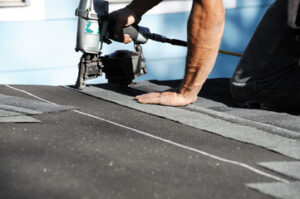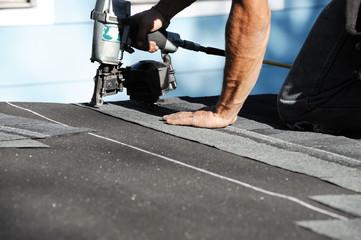Your roof provides a layer of protection that keeps the contents and structure of your home safe. However, it needs to be maintained to function properly.
The most basic roof maintenance tasks include removing debris (leaves, twigs, and trash), clearing drains to prevent ponding, and cleaning soffits to avoid rot and mold.
 Trim Tree Branches
Trim Tree Branches
Trees can add beauty to a landscape, but they can also pose risks if their limbs get too close to the roofline. If the limbs fall, they can cause significant damage to your roof and property. They can also hold moisture where it doesn’t belong, causing rot or mold and giving access to pests.
Keeping the trees at least six to ten feet away from your house is recommended, and it’s important to keep them regularly trimmed. This prevents the limbs from becoming too large or from touching your roof and can reduce the likelihood of them falling, which could lead to expensive repairs or even an entire roof replacement.
If the limbs touch your roof, they can damage the shingles and lead to leaks. They can also collect leaves and other debris, which can clog the gutters and cause water to back up onto your roof and through the walls of your home. This can also create conditions for the growth of mold and moss, which can damage your shingles.
It’s best to hire a professional arborist to trim the trees around your home, as they have the training and experience to ensure that the work is done correctly. They can help you plan how to prune the branches so that it doesn’t compromise the health of the tree and ensure the safety of your roof and the surrounding property.
The professional may recommend crown reduction, which is a process of removing specific branches to help reduce stress from weight and other factors that can cause damage or death to the tree. This method can be done over some time and should only be conducted on mature or older trees.
To properly trim a branch, start at the base and make a cut about an inch up from the base of the trunk, or the “branch collar.” Move a few inches up from this cut and make a second cut about one-third of the way into the limb. Finally, make a third cut at the top of the limb, but no more than an inch past the first cut.
Inspect The Flashing
A majority of roof leaks are caused by flashing damage, so it’s important to regularly inspect the flashing. The flashing is metal strips that are installed at the seams and edges of the roof. It also runs around any chimneys, vents, or other penetrations on the roof. It keeps water from running underneath the shingles and into the structure of the house.
The flashing should be inspected for cracks, gaps, rot, and rust during roofing repair and maintenance. It should be inspected in safely accessible places such as dormer vents, skylights, and roof-to-wall transitions.
You should also check for moss and algae on the flashing. If they are allowed to grow, they can deteriorate the caulk and create holes that will allow water into the home. A roofing professional can reseal the flashing and install zinc or lead control strips to prevent moss and algae from growing back.
If you see any rust on the flashing, it should be replaced right away. A small amount of rust is okay, but too much can cause it to corrode and break down. If it’s too much, you may need to replace the flashing altogether.
In addition to rust, you should look for any areas where the flashing is cracked or bent upwards. This is a sign that the flashing is not protecting the roof correctly. If the flashing is damaged, moisture will run into the unprotected crevice and can lead to leaking shingles.
The flashing should be resealed to prevent any water from entering the roof. This is especially important during the winter, when the weather is more harsh on the flashing. If you notice any leaking or cracking, call a professional right away.
The best way to ensure your roof is properly inspected is to contact a local professional roofing company for a free inspection. A roofing company can provide you with quality roofing services that will last financially and structurally for years to come. Call us today to schedule your appointment! We offer a variety of payment options, including financing, to fit any budget.
Clean The Gutters
A well-functioning gutter system collects rain that falls on the roof and diverts it through downspouts away from the foundation of your home. Without gutters, water would fall behind the soffit and siding of your home and then seep down into the basement or crawl space. If this happens, the rotting and mold that can occur may damage walls and flooring as well. Gutters also protect your landscaping by preventing the garden beds from becoming swamped with puddled and saturated soil. This can kill common landscape plants like hydrangeas, viburnum, rhododendrons, and maples that need well-drained soil to thrive.
Clogged gutters can lead to the overflow of water, which could cause shingles to rot and create a host of other problems. Overflowing gutters can also encourage the growth of mildew, mold, and other microbial fungi that can spread to drywall, carpeting, and other surfaces. This can cause a host of health problems, especially for those with respiratory issues or allergies.
Cleaning gutters regularly is the best way to prevent clogging and overflowing. However, if you don’t have the time to keep up with cleaning the gutters regularly, you should consider investing in a gutter protection system that can help prevent clogging and overflowing. There are several different types of gutter guards available on the market that can be installed to allow running water into your gutter but block leaves and debris from entering.
When you do clean the gutters, use a ladder to reach those parts of the gutter that are difficult or unsafe to get to. You should also wear gloves to protect yourself from the grime that is stuck on your hands. If you are concerned about falling off of the ladder, securing it with a piece of wood or a bungee cord can make it safer to work. If the gutter is very clogged, you can also use a power washer to blast away the dirt and grime. Just be sure to point the nozzle away from your house, and don’t spray the windows or the siding.
Replace The Caulk
Unless you have a very strong roof, certain parts of the structure need re-caulking to stay in good shape. Caulking is typically used around the chimney flashing, shingles, and other areas of the roof that need a waterproof seal. However, it’s important to remember that caulking isn’t a leak stopper; it’s simply a temporary fix to prevent water from seeping into the building.
It’s a good idea to replace the caulking on an annual basis or when you notice signs that it has worn down. You can use either commercial or homemade caulk remover to soften the old sealant and make it easier to peel away. It’s important to follow the directions of your particular product to ensure you don’t cause any damage or create noxious fumes during the process. The caulk softener may take several hours to work and could need multiple applications before it’s ready for removal.
When you’re re-caulking, it’s a good time to inspect the other parts of the roof for wear and tear. Check the flashing for rust or other signs of deterioration, and look for moss and algae that can grow between the shingles. Using zinc or lead control strips can help you eliminate these problems before they grow out of control.
You should also take this opportunity to inspect the plumbing vent boots. These are plastic, metal, or two-piece metal units that are designed to fit over the top of a vent pipe. The boots can rot or crack over time, and they can let water in where the vent pipe leads into the house. It’s a good idea to replace these as needed and re-caulk the joints, especially if the rubber boot has cracked or rotted.
Performing regular maintenance on your roof can keep it in good condition for years to come and save you money on energy costs and repairs. Be sure to do a thorough inspection on an annual basis and address any issues immediately before they become bigger problems. Getting ahead of roof repair and maintenance issues will protect your investment and make the home more comfortable for you, your family, and any guests you have.
